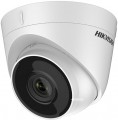Backlight compensation
—
WDR (Wide Dynamic Range) — extended dynamic range. WDR technology combines several frames with different exposures into one picture, as a result, dark areas are brightened, and overexposures are darkened, and the output is a picture with extremely uniform lighting. The true wide dynamic range technology is called True-WDR and it is implemented in the optical circuit at the hardware level, a special microprocessor is responsible for creating and mixing exposures. A more affordable alternative to wide dynamic range is Digital-WDR technology, which equalizes lighting through software algorithms.
—
DWDR (Digital Wide Dynamic Range) — extended dynamic range technology based on software brightening algorithms. DWDR brightens too dark areas of the frame, which can be completely blurred against the background of light areas. Digital brightening allows you to noticeably improve the quality of shooting in contrasting lighting conditions. Digital WDR cameras are noticeably cheaper than true True-WDR optics. Of course, the quality of digital brightening is inferior to True-WDR.
—
BLC (Back Light Compensation) — backlight compensation technology. This system is based on the work of digital signal processors DSP. So, the device, relatively speaking, "breaks" the frame into many segments, making its own adjustments to each of them. Backlight compensation brightens dark areas of
...the frame well. The main disadvantage of the technology is the increase in the brightness of the already bright areas of the frame, due to which overexposure may appear in the picture.
— WDR+BLC. The camcorder supports several lightening technologies at once, each of which is described in more detail above. Immediately, we note that the combination of WDR + BLC allows you to achieve an extremely clear and clear picture in almost any lighting conditions, from extreme contrast to insufficient and excessively bright.
— DWDR+BLC. The device supports two popular clarification technologies at once, each of which is described in more detail above. The presence of DWDR + BLC technologies allows the camera to effectively brighten the dark areas of the frame. Such video cameras have proven themselves well when working in low light conditions.Horizontal viewing angle
Horizontal viewing angle of the surveillance camera. For models with a variable value, the maximum value is indicated, since it is the width of the image that is important, and when zooming in, the zoom factor is more important than the angle. This paragraph also indicates the general angle of view for models with a circular field of view – in particular, cameras with a fisheye lens (see above)
The wider the viewing angle, the more space the camera captures and at the same time, the smaller the images of individual objects in the frame are obtained. Therefore, when choosing by this parameter, it is worth deciding what is more important – the ability to view a large scene or the visibility of small details in a relatively narrow field of view. Also note that with a wide field of view (100° or more), characteristic distortions can be observed at the edges of the frame, and the wider the angle, the more pronounced they are. This phenomenon can be eliminated by panoramic shooting (see "Design and features"), but this feature, in turn, complicates and increases the cost of the camera.
Vertical viewing angle
Vertical viewing angle of the surveillance camera. In models with a variable value, the maximum is indicated, and the angle when zooming is not so important.
The wider the viewing angle, the more space the camera captures and at the same time, the smaller the images of individual objects in the frame are obtained. Therefore, when choosing by this parameter, it is worth deciding what is more important – the ability to view a large scene or the visibility of small details in a relatively narrow field of view.
Video compression format
The video compression format used by the camera.
Compression is used to reduce the file sizes of captured video; different technologies can be used for this — the so-called codecs, their list is given in this paragraph. From a practical point of view, compatibility with external recording and playback devices primarily depends on the supported codecs. If you plan to use a computer as a recorder / player, you can ignore this list: modern PCs and laptops usually support a very extensive list of formats, and in extreme cases, the missing codecs can be installed separately. But if we are talking about specialized registrars, individual players (like home media centers), etc. — codec compatibility should be clarified further. So, if the advanced modern
H.265 standard is very widely supported nowadays, then the more specific
H.265+, originally created for surveillance systems, is much less common even in specialized equipment.
Vandal-resistant body
Ruggedized housing providing enhanced protection against damage attempts.
The specific degree of strength may vary. For example, many manufacturers use the IK standard for impact resistance. The highest rating in this standard is IK10, providing protection against impact with an energy of up to 20 J, which corresponds to a 5 kg load falling from a height of 40 cm; more detailed information on IK can be found in special sources. At the same time, cameras that do not have IK certification can also be positioned as vandal-resistant.
Note that even the most
vandalism-resistant housing does not provide absolute protection against damage. However, this feature, anyway, significantly complicates the attacker's task and may even force him to give up trying to permanently spoil the camera. And the purposeful removal of the camera from the system turns out to be a rather difficult and long matter. And in some models, the increased strength of the case can be combined with other features — for example, a sensor that sends an alarm when attempts are made to damage the camera.

